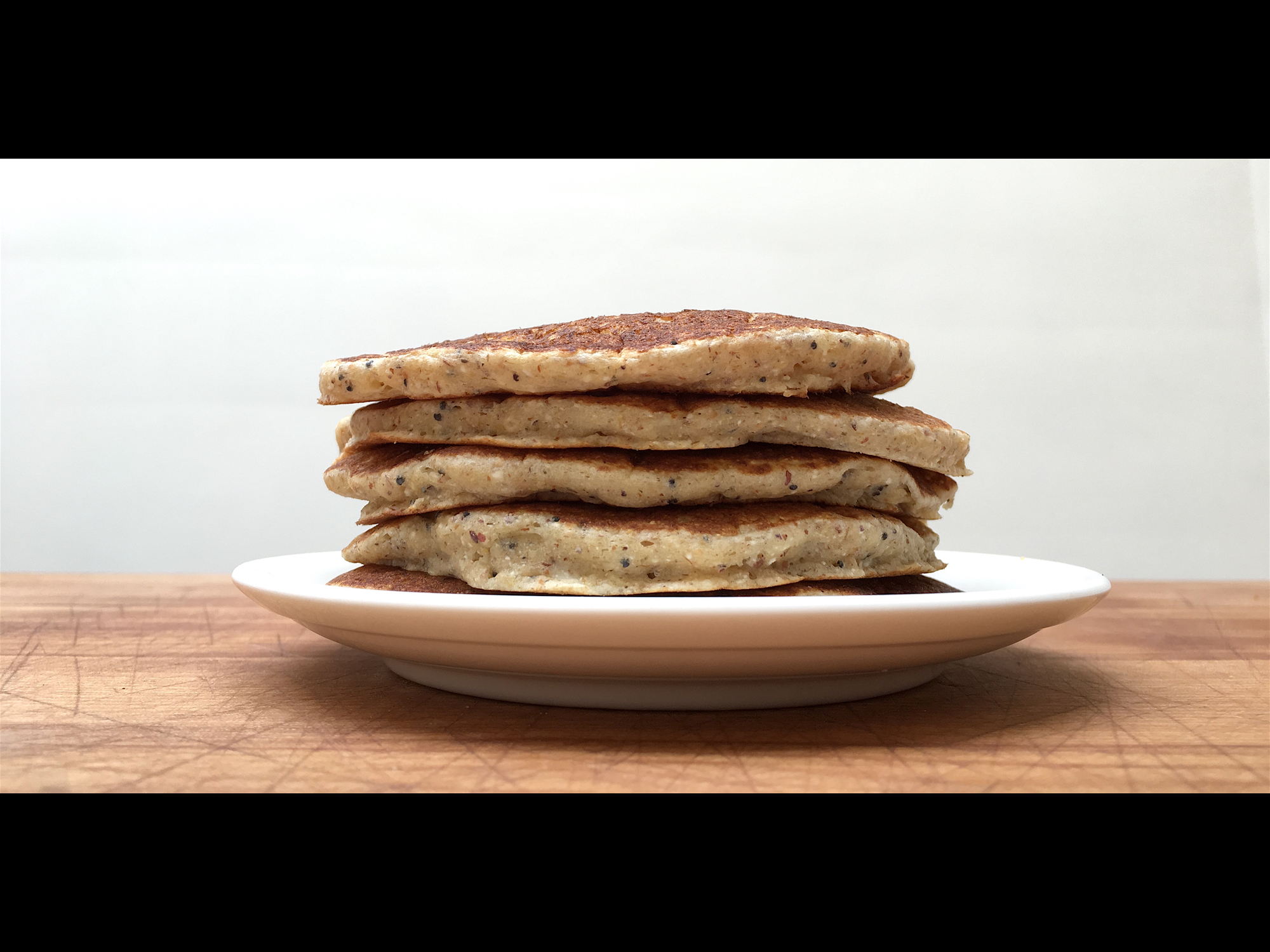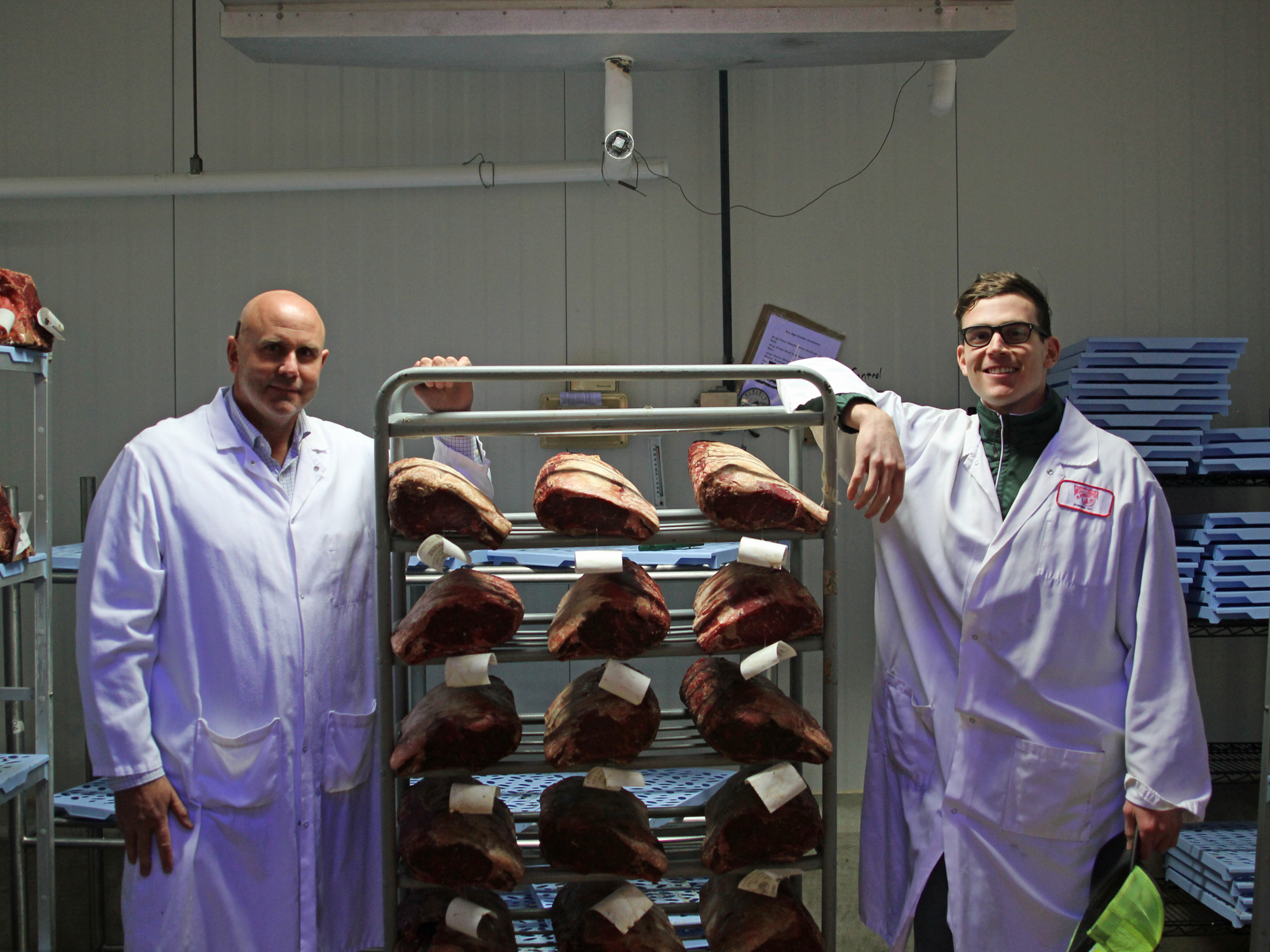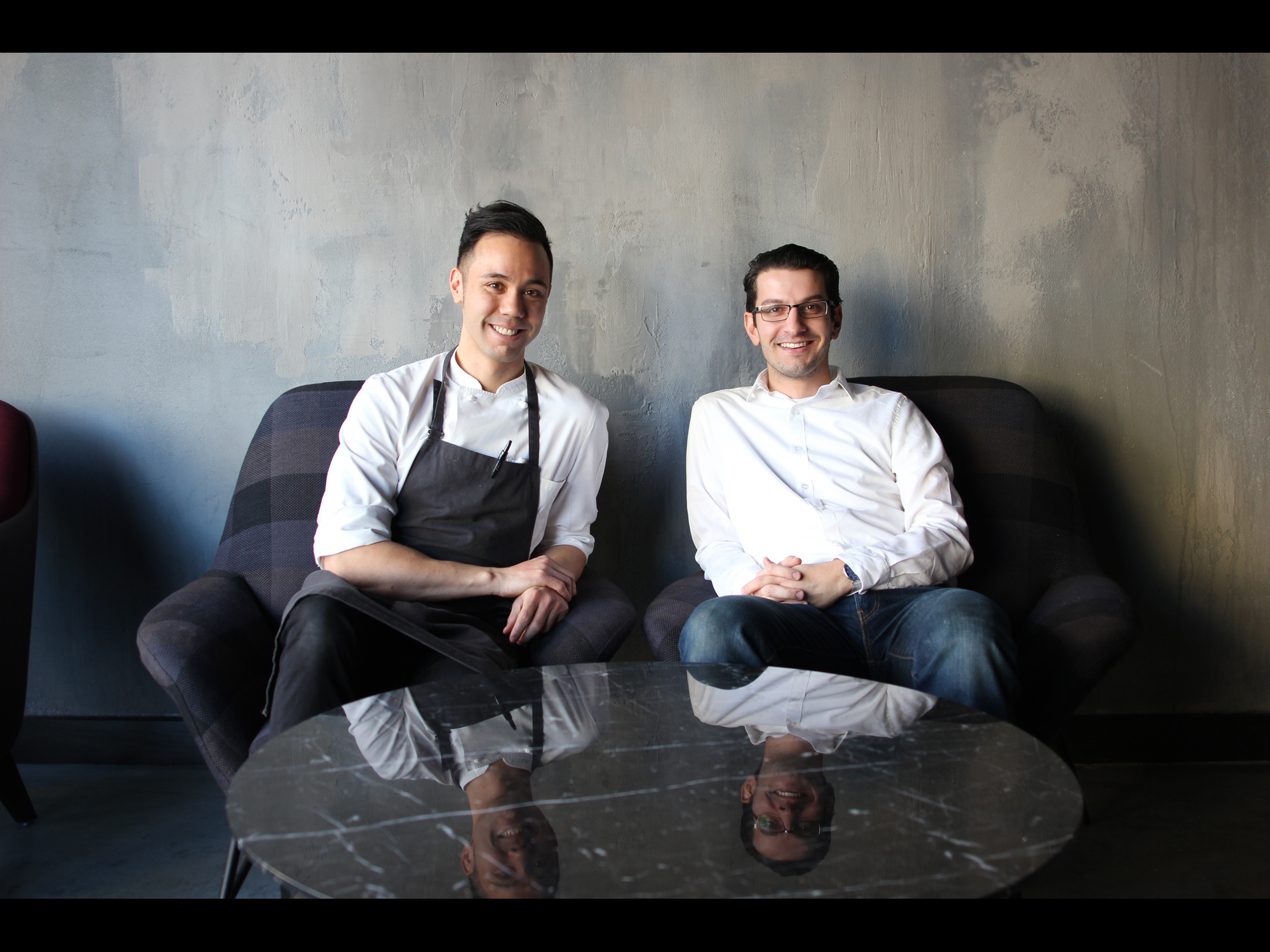BAND OF BOHEMIA IS A BREWPUB, technically—a restaurant attached to a brewery. That’s the category, but if you immediately got a picture of Angus burgers and pulled pork sandwiches with fries, try again. Started by two guys who met at Alinea, sommelier Craig Sindelar and baker/brewer Michael Carroll, Band of Bohemia from the start approached both food and beer—not to mention wine and cocktails—with a more sophisticated point of view, in which fine dining food and culinary beers (made with food ingredients and spices) were meant to work together and enhance each other.
Physically, too, Band of Bohemia breaks with expectations—at a time when independent restaurants tend to be shoeboxes serving small plates in West Randolph or Logan Square, Band of Bohemia launched in a big factory space next to the railroad tracks in the Ravenswood/Lincoln Square area, filling it with beer tanks and hipster mittel-European decor. There was reason to question whether that all made sense—quirky housemade beers, posh food, a half-hidden location further north than today’s foodie audience mostly went (though it did have Elizabeth, a few blocks to the north and west, for precedent).

Chef Ian Davis, brewer Michael Carroll, and general manager Craig Sindelar
I went early on—it was actually the same night we recorded this, and some of the same people—and it was a bit of, I didn’t quite get it, and they didn’t quite have it all together yet (one of the culinary beers that didn’t do it for me used beets, and Carroll admitted when I brought it up that he’s gotten a lot better at brewing with that ingredient). I meant to go back, but other things kept opening before I could get back, and in any case someone else tried them and liked them a lot. Almost a year to the day after they opened, in November 2016, Michelin gave them a star, making them the first and so far only brewpub in America to gain that honor.
Recently I went back to check out a new chef, Ian Davis, a former pro boxer who came from David Chang’s restaurants in New York, but with Chicago stops including Blackbird on his resume. This Band of Bohemia works like a well-oiled machine, the promise of two years ago now mature. It seemed a good time to talk with the crew behind Band of Bohemia, and so Carroll, Sindelar, Davis and I met recently.
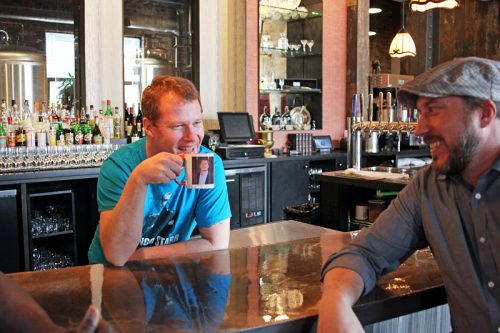
1. Never Seen a Place Like This
CRAIG SINDELAR: Michael had approached me when I was still at Alinea in 2009 or ’10 with two pages of an idea. He said, read this, see what you think. He knew that I was looking to do my own thing, though I was more wine bar, Spanish tapas, etc. with my experience in northern Spain.
So I read this beautiful two-page description of this dream he had. And first reading, I thought, I’ve never seen a place like this. I don’t know what that is, but I’m very intrigued.
Over the course of a couple of years, we put the business plan together, we started looking for investors and spaces, which took a lot of time. But this in fact turned out to be very close to what’s in that original two-page report. It’s pretty similar, except that there’s no basement tavern.
MICHAEL CARROLL: I’ve been brewing since I was 20—actually I’ve been into beer since I was a late teen, don’t tell my mom that. “Were you drinking?” Well, I was drinking good beer, Mom, so at least there’s that.
But I started getting into Belgian beers, and German beers, and as the bread baker at Alinea I’d go home in the middle of the day and cook myself a good meal and have a really nice beer with it. So that was really how it started. It went great together, it just seemed natural. And then you’d go to places like brewpubs where they’d have high-rent beers, and it never really went with the food. There was never that synergy.
I was working at Half Acre when I got approached by Joe Catterson at Alinea and Next if we could make a beer for Next’s Thai menu. And I thought, I’d love to. And we started throwing around ideas and it came to be this mangosteen hibiscus… and something else… anyway, a nice beer, nicely balanced. And they put it on their menu and it went great with the dishes.
And from there it turned into, hey, you can actually make your own beer and put it with a menu in a finer dining setting. Beer’s always had a back seat when it comes to restaurants in general, how it goes with food, so the idea for me was, make beers that go with food.
SINDELAR: The term “ambitious,” maybe “overly ambitious” is what we heard over and over. From investors to bankers to colleagues in the industry, people said, that might be just a little too big for your first venture.
Originally this was going to be a 40-seat restaurant, with beer—a small three to five barrel system and a kitchen. But you start crunching the numbers, that can’t work. We saw, we needed to have at least 75 seats—now the numbers start to make sense—and we’re looking for about 5000 square feet then. We’re currently at 110 seats, which I think is a sweet spot that we’re able to manage, or at least could from the beginning.
We had investors tell us, maybe you should just do the beer, because that’s where the margins are. But then the concept doesn’t really work because of the style of beer that Michael creates. You need the food and the beer—it’s a cohesive idea. So then people said, you’re both restaurant guys, maybe you should do the restaurant first. But then we’re just a restaurant, and we’re in a neighborhood where that could be challenging.
FOODITOR: Were you looking at this area from the beginning, or did you consider locations all over?
SINDELAR: We were all over—
CARROLL: We hit almost everywhere, Pilsen, Logan, Andersonville, Portage Park. We hit a lot of them and this just spoke to us the most. It has that feel, we’re in the city, but we’re not. We’re kind of in the country, but not really.
SINDELAR: And the building, the structure was what we were looking for. We kept coming across just that traditional “shotgun” restaurant [a long, narrow Chicago building]. Coming this far north, we took a chance that we want to be somewhere long term. But we were looking for longevity in the industry, and honestly I don’t think we would have had that on Randolph, even though the options were there.
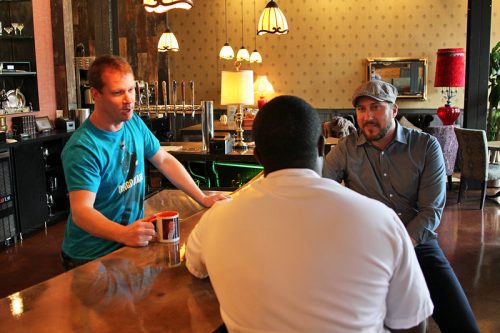
2. Beer With Food
A lot of people seemed to go into the idea of adding botanicals and fruit and so on to beer around the time you did—I suppose it was the pendulum swinging the other way from everything being a hoppy IPA, and certainly necessary if you were going to make a beer that was meant to go with food.
CARROLL: There’s no creativity in just dumping hops in something. Mind you, there are places that do it very well, and then there are places that don’t, but keep doing it—and they sell them. But it’s decently easy, just dumping more in, and so I think the people who had a little more creativity got tired of it, and started to go into that different realm. I mean, hops are a new thing—they’ve only been around the last couple of hundred years. That’s not very long in the grand scheme of beer.
Were mangosteens the first things you played around with like that?
The first thing that I made that was in that realm was the orange chicory rye. That was the first beer I made with Half Acre, called The Empty Sea. It also was the first bread I made at Alinea, trying to come up with something creative there. And so, keeping that theme going, the first beer I made here was orange chicory rye.
So that was the first one they let me make, Half Acre, and they thought it was weird but they let me do it, and in the end it was really good—so they’re like, “Hey, maybe there is something to what you’re doing.” They would toss me a bone every now and then of just making my own thing.
So when you first opened, how did that collaboration work between the chef and you as the brewer?
SINDELAR: Matt DuBois was the opening chef, and it was his menu, but Michael was, I guess, the executive chef, and everything would filter through Michael and myself.
Everything starts with the beer. This is the flavor profile, take that, what’s going to go with this? And we have about three to five weeks to get that going.
CARROLL: Seasonality always has to play a part—a lot of it is just my own personal background, I spent a lot of time in Oregon, so a lot of that plays into what I do. And food usually goes with other food that’s in the same season. So in making the beer, the beginning part of it is, what flavors are you trying to get in here—fruitier notes, more caramel notes, raisin character, bready character, different types of grains that you could add. What other elements that you could add to that, that would benefit each other.
And then from there, before you’re making it, you’re thinking about what foods would go with it. And so, it’s got caramel notes—so vanilla. There’s pears in it, so what goes with pears. You get a gut idea of what can go with it. Say orange chicory rye—what goes with orange? You’ve got a good list.
And then, you make a dish, you try it, it needs more acid, it needs more sugar, it’s too gamey, it’s not gamey enough, whatever the case may be. We come into play when it comes to what goes on our menus, it does have to go through us. We have a big hand in that, critiquing it—what’s it missing? What’s it too much of? But we’re fortunate now to have Ian here, who kind of hit out of the park from the start—
SINDELAR: Makes our lives so much easier.
So is it more, he’s working on a chicken dish, let’s make what goes with that, or—
CARROLL: We haven’t done that yet.
IAN DAVIS: It’s more, this is the beer, these are the notes. Everything starts with the beer. This is the flavor profile, take that, what’s going to go with this? And we have about three to five weeks to get that going.
CARROLL: And if after a certain amount of time we change the beer that goes with a dish, we’ll tweak the dish—maybe it needs more acid, or whatever the case may be. Or it could get to a point where it could be completely different—we’ve done that enough, let’s just change it. Try something new.
Do you kind of have slots for beers, so if you retire a dark beer, you make another dark beer, that sort of thing?
CARROLL: Exactly. That’s the best way to put it.
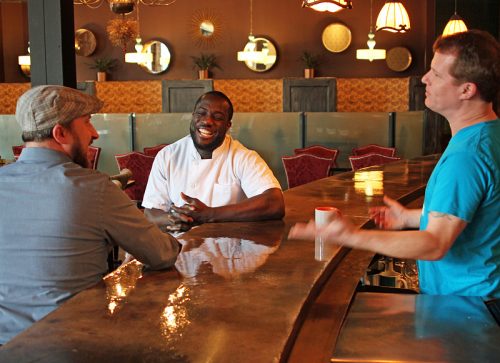
3. Chef in a Beer Hall
So Ian, I have to think this is the most beer-driven place you’ve worked—
DAVIS: It is, it’s different. It’s totally different.
It forces you to think outside the box. So where normally you would think of an idea and just build off that idea, now you have a blueprint. And you have to format within that blueprint. Which is great.
CARROLL: It’s an interesting part of the process, and a lot of chefs we talked to just never got it. “You mean I can’t make my chicken dish with lemon and thyme?” Well, you can, but change it to sage, because that works with the beer. “But it’s… lemon and thyme.”
They couldn’t get past that part of it, where with Ian here, he can taste it and go “Ah.” You create things that you wouldn’t normally think of.
SINDELAR: And I think what’s most interesting about the menu is, it’s hard to nail down what type of cuisine it is. You just get to create brand new dishes.
CARROLL: If soy works, you put soy with it. If curry works, you put curry with it. If mole, then mole. So what are you, a Mexican restaurant—
DAVIS: Asian, Italian…
CARROLL: That was kind of the initial point of it, it doesn’t have to be anything.
Tell me how something on the menu came about, starting with a beer.
DAVIS: Well, let’s talk about the duck dish. It was meant for the India Pale Ale—a bunch of spices, coriander. And I was at home, and I’d had duck curry two weeks before that at a Thai restaurant, so I’m thinking curry, coriander—that goes well together.
Band of Bohemia, it’s not one person, it’s a band that comes together. I can’t taste the beer before it’s complete and pick up certain notes. Because to me, it changes drastically when it gets carbonated. Where Michael or Brian or other people can taste it and go, oh this is this. If you tell me the tasting points, I can play it off of that and the dish just developed. Like, the same kind of things you’d eat with the curry—the rice, some type of vegetable, cilantro, lime, spices.
Now my criticism of the menu early on was that there were some really good things, but it tended to be a lot of appetizer-like things—heavy on proteins, not really a balanced meal. And when I went again a few weeks ago, it seemed more like whole plates of food, at last. A variety of flavors and textures and types of food on the plate.
I know what you mean. I think the dishes now are complete, they’re well-rounded dishes. It’s not like your hotel, meat-vegetables-potato plate, but I think everything on the plate has a purpose. And every purpose on the plate goes with the beer.
So, I guess it’s instinctive. Take the eggs on eggs. It’s something simple, eggs, caviar, butter, brown butter bits, crumble texture and chives. To me, that’s a complete dish.
SINDELAR: The dishes were different before. I liked it, it was a different style than we’d seen before, lots of grains, lots of housemade vinegars, kind of scattered about the plate—it was a different look. I feel that the plates are much more complete now, and there are layers of flavors to the food now.
CARROLL: I think that was kind of the style of dishes a couple of years ago, a protein with some sauce and a micro green on top. I think we’re getting away from that, adding that fine dining element with the grains, the vegetables, not just the protein. I mean, Dave Beran’s vegan menu at Next was one of the best things I’ve ever eaten, and I don’t know how he did that. I think the goal is to get to more of a balance, now.
SINDELAR: Everything is about coming to a balance—the beer, the food, the wine, the cocktails, everything coming together.
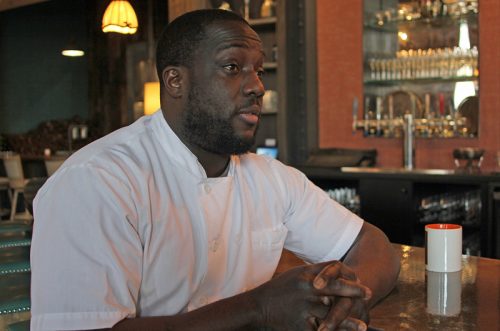
4. The Boxer
Ian, tell me how you got interested in being a chef.
DAVIS: I kind of fell into it. I used to box, and I dropped out of college to turn pro.
And my mom told me I had to have a job or be in school. So I got a job washing dishes. I broke my hand, so I couldn’t box. And I fell in love with the fast pace, people were talking trash, it was fun, and my sous chef, chef de cuisine and executive chef all went to the Culinary Institute of America. So I was like, okay, come home, Mom, I know what I want to do with my life, again. I want to be a chef.
She was like, sure, no problem. If you really want to be a chef, you pay for it, you pay for your first semester. And I was like, okay. So for about six months, I saved money, applied, got into the CIA, and that was it. It cost a lot, but I did it, and then everybody went on their externship, and everybody was trying to go to New York. And I asked my advisor, I can go anywhere? Yeah, you can go anywhere in the world. And everybody was saying London was like New York, so I went there.
That was actually one of our goals, we hoped to encourage people that this can be done, better food with better beer.
I fell in love with it, and stayed a little over a year. Came back, finished school, and then I went to Union Square Cafe and worked there for about a year and a half. We did an event there for the mayor, and Jean-Georges [Vongerichten]’s cooks drive up in black SUVs and get out, all stylish, and I was like damn, I want to work with them. They didn’t take the train.
So I staged, got a job with JG, worked there for about a year and a half, and then the roommates I was living with, we all decided to move out. So I put a bunch of cities in the hat and picked Chicago, Googled the top ten restaurants in Chicago. I came out, staged, worked at Tru for about a year, and then went to Blackbird for two and a half years.
Hurricane Sandy hit. All my family was still in New York, I felt bad, worked for David Chang for almost four years. And then every year we would do an event, or James Beard or whatever, and I realized, damn, I miss Chicago. Little things, like getting in an Uber or a train and people saying good morning to you. You go back to New York and get off the train and it’s people pushing, and it smelled. Maybe like a year and a half ago, I was like, I kind of want to move back.
You can do more. Our landlord let me know that our rent was going to go up to $2200, and we were living in Brooklyn, so it was like $1100 a piece for a one-bedroom in the middle of nowhere—it just didn’t really make sense. I found a place, moved back, worked with Danny Del Vecchio with the Jean-Georges group at The Pump Room, closed that. And then it was like you can either move back to New York, or L.A., and I kept looking on Culinary Agents [a restaurant job site] for jobs, and I kept seeing Band of Bohemia, Band of Bohemia. And I’m like, all right, it’s a brewpub, let’s check it out.
I drive up, and it’s like all right, this is a warehouse. But then you walk in and it’s like, oh snap. And then I sat with them for like an hour and a half. We talked about everything from Reno to Oregon to life and food. And what really struck me was, this is a place where everyone has different traits, and they come together under one roof, and showcase them. I thought that was dope, but you fast forward to now—somebody told me that this was one of the most complete meals I’ve had, from coffee to tea to cocktails to beer to food to service.
Union Square was predominantly Italian, pastas, gnocchi, Jean-Georges was French with Asian techniques, Tru was your classical French with American nuances, Blackbird was American fare, David [Chang] was Asian-esque, just something had to be in that format. Here, you just gotta make sure it pairs well with beer, it’s Bohemian, it’s nothing and it could be anything. Your mind can go to Italy, France, any of these places that I’ve worked.
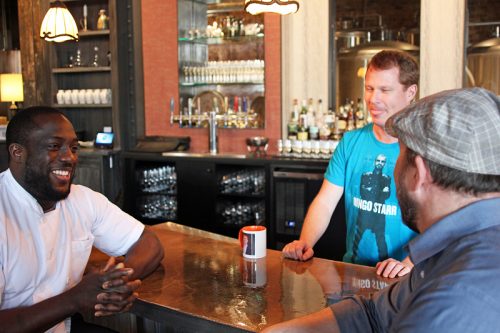
5. Michelin Calling
So it must be doing well, the place seemed full the night I went—how has it gone as a business since you opened?
SINDELAR: It’s been a learning process—working in other businesses, even with some of the back office experience, still doesn’t prepare you for owning the restaurant. I think us staying flexible, in the beginning, and realizing what’s working and what’s not working, and being willing to talk about it with our team and change it, has made a huge difference. Switching over to Open Table—I love Tock, I like how it works, these are friends of ours, so it was hard to say, we need to make a change, but for the type of crowd that we had at that time, Open Table made more sense.
We were open for coffee at the beginning—
I know, I came here once for coffee, too—
CARROLL: Thank you!
SINDELAR: You and ten other people!
We thought, we have the busiest Metra stop on the north side, 2500 people a day, this is going to be great! And what they do is, they filter right down the stairs and into the Mariano’s on the corner. And realizing that, that’s just not going to work, and that’s how our brunch came about, and it’s very successful.
How did getting a Michelin star affect your business? Did you ever think that could happen to a brewery restaurant in Lincoln Square?
It was a surprise. In our business plan we had written that we would work with the mentality of a Michelin star restaurant, but we weren’t going for a Michelin star—it’s a brewpub, they’re never going to give us this prestigious award, why would they.
It was a very humbling surprise, and it was great, and it changed—it’s kept us in business. Because like we were talking about earlier, we’re taking a chance being a 20, 25-minute drive from downtown. It’s pretty easier to get here, but it’s pretty hard for people to grasp—Ravenswood where?
Though now you’re in this pocket of Michelin restaurants in Lincoln Square and Ravenswood, with Elizabeth and Goosefoot.
Everyone’s got one! Mariano’s has one.
CARROLL: Alderman Pawar hands them out when you open up in the 47th ward.
SINDELAR: No, it’s been huge for us, and when I look back on the last couple of years, really getting a solid team has been important for us. I think we’ve finally reached our point where we’re balanced, front and back of the house, which allows Michael and myself to focus on some other things that we should be doing, as owners and allowing the team to run a little bit. I think we’re due in the future to see some new and exciting things, which happen when you allow people to be creative.
CARROLL: We allow people to have a say in what happens. We have biweekly leaders’ meetings. We just sit in the office upstairs and we’re like, what’s going on? Service issues, kitchen issues, and so on. It allows them to change things, we’re doing this in service but it’s not really working, so… it keeps people interested, it keeps people creative. Hopefully, when any of these people move on and go someplace else, proudly you say that you worked here, and everybody looks at you and goes, oh damn.
Now, one thing that has changed since you opened in late 2015 is how many tap rooms we have now, offering beer and more aspirational food. Several of them are fairly close by, in fact. Has that affected you?
At least in this neighborhood—which is now Malt Row, they’ve dubbed it—actually, every brewery in Malt Row is somewhat different from the others. Half Acre has their niche, Begyle has their niche, Dovetail do very German beers, Spiteful has their niche, we have our niche. In one very small area, you have very different styles—if you don’t like what we do, go to Half Acre, go to Empirical. So at least in this area, all it’s really done is saturated it and made it more diverse. It’s hard to get a tap line at somebody else’s place now—back in the day Half Acre would have two taps at a place, now you’re fighting to get one.
So a lot of that’s a bit problematic, and we do distribute, but we’re more focused in who we send it to and our bottle stuff is just to small shops. For us, we’re not that pent up about distribution too much. It’s nice to be out there, but we don’t want to be somewhere that we just get lost. We want someone who’ll talk us up, as opposed to, “Well, there’s your German section, and there’s your Belgian section—good luck.”
SINDELAR: You mentioned brewpubs, and one thing we’re starting to see, and we receive a lot of emails and contact information about, is other brewpubs calling and asking, how is this going, how is this working for you? Or they come in and say, we want to open a brewpub and elevate our food as well. And that was actually one of our goals, we hoped to encourage people that this can be done, better food with better beer, and we’re starting to see a lot of that now—out of state, and internationally. Which is great to hear.
Also a Michelin effect, I imagine.
CARROLL: Since we got our star, we get a lot of brand people, either coming in or, I think it was Edmund’s Oast in Charleston that said, the day after we got it, they had a team meeting and threw the paper down and said, this can happen.
SINDELAR: They were already heading that way, so it was encouragement that yes, we are going in the right direction.
CARROLL: About time, really. I mean, beer and food is a great marriage and it works, hopefully we’re some proof of that.
SINDELAR (whispers): Wine’s good too.
CARROLL: We’ll see how it works out. I think also, having brewpubs in general is better. One of the things we also wanted to be, being up here, is the neighborhood brewpub. Like it was back in the day—you didn’t buy beer at the store, you went to your local space.
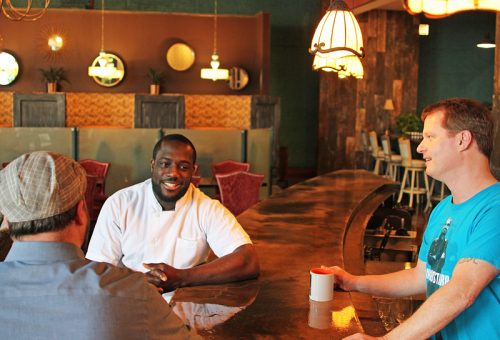
I get the feeling Craig wants to talk about wine.
SINDELAR: Nope, not at all. Actually, it’s one thing we don’t talk about much, and for a good reason, the focus is on the beer. However, if somebody were to ask, is it a complete restaurant, yes, there are 30 wines by the glass, I’d like to think that they’re well thought out and pair well with the food, and a cocktail program, which is just getting better and better. Chris Visic, up from Nashville, he’s a young star, to watch out for. His techniques, his calm manner, how consistent his cocktails are, makes him someone to watch out for. They make me smile every time I drink one of his cocktails.
CARROLL: He’s also sneaking in the beer and spirit pairings.
SINDELAR: We have such unique beers, and sometimes, when I go out at the end of the day, I just want a beer and a really high quality spirit. So all of our beers have a pairing of a spirit that you can order. And they just complement our beers.
The tea and coffee program is also two, three steps up from where it was a year ago. Tom Santelle runs our coffee and tea program and has a strong relationship with Dark Matter, and they go down and taste periodically. The coffee’s fantastic, but how creative he’s being with the coffee is what’s so important here. He pairs the same way beer and food do, being seasonal and looking at what’s coming up on the menu. The flavor profiles of his coffee, and the things he’s adding to it, the aromatics are meant to go with, and at least tie into the menu. We’re getting closer and closer to actually pairing teas and coffees and the food together.
One last question—so you had a name for this place, and I’m sure you’re thinking, what a unique name, nobody else will use Bohemia in their name—
CARROLL: My idea of Bohemian was more like 19th century French artists, and I was always a fan of Jimi Hendrix’s Band of Gypsies, but since he already had that, that name was taken. It’s kind of just a group of hippies, really, a group of artists. People that think for themselves and have traveled the world and, like Ian said, wherever you’ve been, you bring to here. Everybody in the restaurant industry, you get to a certain age like we are at this point, we’ve traveled. So that’s really what we are, a band of people thrown together who have their own nuances on life.
And knowing Craig, he’s actually of Bohemian descent, so that adds another layer.
SINDELAR: But it confuses people, no question. “You’re a band of musicians?” No. “It’s Bohemian food!” No. And then Bohemian House beat us by a year, and we’d already had it LLC’d out so it was set in stone… We get calls once a week for them. Or, “I don’t see your name on the reservation list, maybe you called…”
CARROLL: “But you’re here, wanna hang out?”
Michael Gebert lives la vie boheme as editor of Fooditor.
Latest
Join the Discussion
After you comment, click Post. If you're not already logged in you will be asked to log in or register with Disqus.





